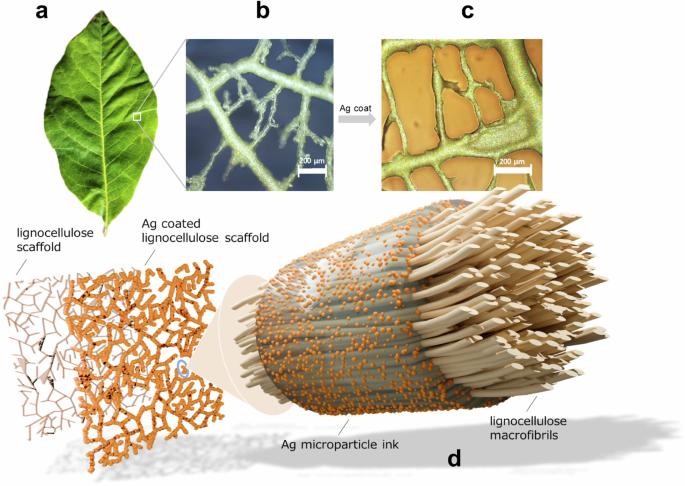将源自树叶的木质纤维素支架金属化,用于高性能柔性电子器件和低聚消毒剂
IF 12.3
1区 材料科学
Q1 ENGINEERING, ELECTRICAL & ELECTRONIC
引用次数: 0
摘要
天然树叶中的维管形成了可金属化的准分形网络。这些木质纤维素结构的传统金属化技术非常复杂,涉及金属溅射、纳米粒子溶液或多种化学预处理。在这里,我们提出了一种新颖、简便、可靠的方法,利用银微颗粒对源自树叶的木质纤维素支架进行金属化。该方法实现了与最先进方法相当的性能,如超过 80% 的宽带光学透射率、低于 1 Ω/sq 的薄片电阻,以及在 2.5 × 2.5 平方厘米准分形电极上超过 6 A 的载流能力。我们还证明了铜电沉积是制造这种导电仿生物准分形的一种具有成本效益的方法。此外,我们还展示了这些金属化结构可有效消除粪大肠菌群和大肠杆菌等病原微生物,这些细菌是水质微生物污染的细菌指标。最后,我们还展示了这些寡动力特性可以在施加少量外部电压的情况下显著增强,这表明此类结构在水净化和污染控制方面具有值得关注的潜力。本文章由计算机程序翻译,如有差异,请以英文原文为准。


Metallization of leaf-derived lignocellulose scaffolds for high-performance flexible electronics and oligodynamic disinfection
Vascular tubules in natural leaves form quasi-fractal networks that can be metallized. Traditional metallization techniques for these lignocellulose structures are complex, involving metal sputtering, nanoparticle solutions, or multiple chemical pretreatments. Here we present a novel, facile, and reliable method for metallizing leaf-derived lignocellulose scaffolds using silver microparticles. The method achieves properties on-par with the state-of-the-art, such as broadband optical transmittance of over 80%, sheet resistances below 1 Ω/sq., and a current-carrying capacity exceeding 6 A over a 2.5 × 2.5 cm² quasi-fractal electrode. We also demonstrate copper electrodeposition as a cost-effective approach towards fabricating such conductive, biomimetic quasi-fractals. Additionally, we show that these metallized structures can effectively eliminate pathogenic microorganisms like fecal coliforms and E. coli, which are bacterial indicators of microbiological contamination of water. We finally show that these oligodynamic properties can be significantly enhanced with a small externally applied voltage, indicating the noteworthy potential of such structures for water purification and pollution control.
求助全文
通过发布文献求助,成功后即可免费获取论文全文。
去求助
来源期刊

npj Flexible Electronics
Multiple-
CiteScore
17.10
自引率
4.80%
发文量
91
审稿时长
6 weeks
期刊介绍:
npj Flexible Electronics is an online-only and open access journal, which publishes high-quality papers related to flexible electronic systems, including plastic electronics and emerging materials, new device design and fabrication technologies, and applications.
 求助内容:
求助内容: 应助结果提醒方式:
应助结果提醒方式:


